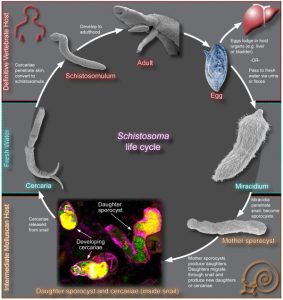This Week in PLOS NTDs and PLOS Pathogens: Understanding Schistosome Biology, Mycobacterium ulcerans Treatment Evolution, Biological Acids in Immunity and Pathogenesis, and More

The following new articles are publishing in PLOS NTDs this week:
Reports indicate that cysticercosis, the tissue infection spread by Taenia solium, while endemic in much of Latin America, has not made effective headway into the Caribbean, with the exception of Haiti. Dr. Kirezi Kanobana and colleagues discuss the case of cycsticercosis in Cuba, where health policy makers are taking no chances and have created a national program dedicated to controlling T. solium.
Dengue affects millions of people every year and the development of a dengue vaccine is a public health priority. In this study, Dr. Hugo Henriques and colleagues describe the use of a dengue virus-derived protein, named non-structural protein 1 (NS1) in an immunization protocol that targets the antigen to dendritic cells (DCs) that are central for the induction of immunity.
The recommended treatment for Mycobacterium ulcerans (MU) has continued to evolve from surgery to remove all involved tissue, to the use of effective combination oral antibiotics with surgery as required. In this study carried out by Dr. N. Deborah Friedman and colleagues, they describe the oral medical treatment utilized for consecutive cases of MU infection over a 15-month period. Their results show that managing patients primarily with oral antibiotics results in high cure rates and excellent cosmetic outcomes.
The following new articles are publishing in PLOS Pathogens this week:
Schistosomiasis is among the most prevalent human parasitic diseases, affecting more than 200 million people in the developing world. Despite the grim statistics, only a single therapeutic agent (praziquantel) is currently used to treat schistosome infection. In this Pearls article, Drs. James Collins, III and Phillip Newmark discuss the experimental attributes of planarians and their potential as a free-living model for understanding schistosome biology.
At least 40 primate species in the wild are infected with their own lentivirus. Host antiviral proteins, called restriction factors, work to defend against both known and novel viruses and are thus engaged in a constant arms race with viral proteins. Dr. Oliver Fregoso and colleagues illustrate a novel phenomenon in which there is an evolutionary toggling of divergent recognition between a restriction factor and its viral antagonist.
Leishmaniasis is a parasitic disease where the host immune response plays an essential role in pathogenesis. However, the mechanisms promoting immunopathology in patients are still unclear. Dr. Fernanda Novais and colleagues demonstrate that activation of CD8+ T cell cytolytic responses is detrimental to the host and that targeting this pathway could be a new approach to treat patients with leishmaniasis.
